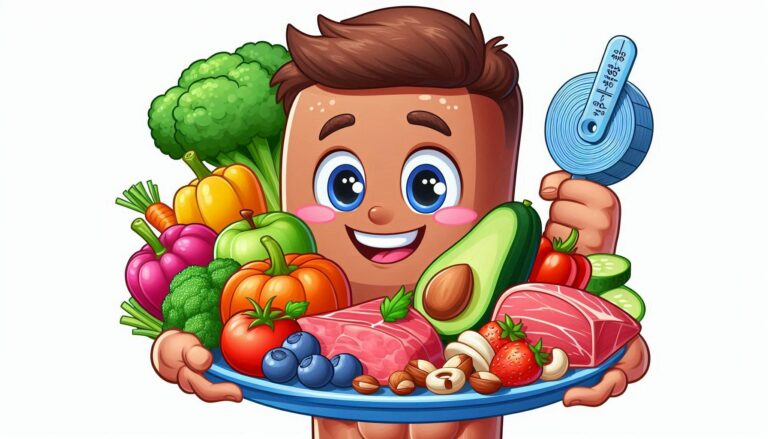Revitalize Your Health: Discover the Ultimate High-Protein Diet for Energy and Vitality

Many people aim for optimal health and wellness. A high-protein diet can help you reach your goals. By eating lean, nutrient-rich protein, you get the building blocks for muscle growth, weight control, and disease prevention. This article will cover the benefits of eating more protein, suggest the best protein sources, and guide you on how to make a high-protein diet work for you.
Key Takeaways
- A high-protein diet can support muscle building and weight loss by promoting satiety and preserving lean muscle mass.
- Lean protein sources, such as chicken, fish, and plant-based options, are essential for a balanced, nutrient-rich diet.
- Incorporating a high-protein diet into your lifestyle can be achieved through various dietary approaches, including the keto diet and paleo diet.
- Bodybuilding nutrition emphasizes optimizing protein intake to support muscle growth and recovery.
- Consulting with a healthcare professional can help you determine the appropriate protein intake and macronutrient ratios for your individual health and fitness goals.
What is a High-Protein Diet?
A high-protein diet focuses on eating foods high in protein and less carbs. It helps with muscle growth, fat loss, and better metabolic health.
Understanding Macronutrient Ratios
The right mix for a high-protein diet is 25-35% protein, 40-50% fat, and 20-30% carbs. This balance is key for muscle growth, fat loss, and stable blood sugar.
Benefits of a Protein-Rich Eating Plan
Eating a lot of macronutrient ratio has many benefits, such as:
- Feeling full and eating less, which helps with low-carb eating and weight control
- Better body shape, with more lean muscle
- Improved sports performance and recovery
- Stable blood sugar and lower risk of metabolic problems
Whether you want to build muscle, lose fat, or get healthier, a high-protein diet can help. Knowing the best mix of nutrients and the perks of eating more protein is a great start to reaching your health goals.
“Protein is the building block of muscle, and a high-protein diet can help support muscle growth and maintenance.”
Muscle Building with High-Protein Foods
If you want to build and keep a strong, toned body, muscle building is key. The secret to this is your bodybuilding nutrition – especially the lean protein you eat.
Protein is crucial for muscle growth. Adding high-quality, lean protein foods to your diet helps your muscles grow and repair. Great choices include chicken, fish, eggs, and plant-based foods like tofu and legumes for muscle building.
These lean protein foods do more than just build muscle. They also help keep your muscles strong, so you don’t lose your gains when you’re not working out. By focusing on lean protein in your bodybuilding nutrition, you can improve your fitness goals and shape the body you want.
- Chicken, turkey, and other poultry are great lean protein sources for muscle building.
- Fish like salmon, tuna, and tilapia offer high-quality lean protein for muscle building.
- Eggs are versatile and rich in nutrients and lean protein choices for muscle building.
- Plant-based lean protein options like tofu, tempeh, and legumes also aid in muscle building.
A balanced bodybuilding nutrition plan with lots of lean protein is key for a strong, muscular body. Add these top-notch lean protein foods to your daily meals, and see your muscle-building efforts succeed.
Weight Loss and the High-Protein Diet
Choosing a high-protein diet can help you lose weight in a lasting way. Protein is key in managing weight by making you feel full and satisfied. This can lead to eating fewer calories. It also helps keep muscle mass while losing weight, which is key for faster metabolism and fat burning.
How Protein Supports Weight Management
Protein takes longer to digest, so you feel full for a longer time. This can stop hunger and prevent overeating. Plus, your body burns more calories processing protein than carbs or fats.
Low-Carb Eating for Fat Burning
- Going low-carb, like in the keto diet, helps with fat-burning and managing weight.
- Lowering carbs makes your body use fat for energy instead, a state called ketosis.
- This change in energy source can speed up weight loss and improve your body’s fat-burning efficiency.
Combining a high-protein diet with low-carb eating creates a strong plan for weight loss and better health.
High-Protein Diet
If you want to improve your health and shape your body, consider a high-protein diet. This diet focuses on eating foods high in protein and less carbs. By changing your diet, you can feel fuller, control your blood sugar better, and build more muscle.
There are different ways to follow a high-protein diet, like the ketogenic diet, which is very low in carbs and high in fat. But the main idea is to eat enough high-quality protein from various sources. This supports your health and fitness goals.
- High-protein diets usually have more protein than carbs and fats.
- Eating more protein can help you look better, feel full, and manage your blood sugar.
- The keto diet is a type of high-protein diet that is very low in carbs and high in fat.
Adding a high-protein diet to your life can bring many health benefits. It can help you build muscle, lose weight, or just eat better. A diet rich in protein could be the way to reach your goals.
Lean Protein Sources for Optimal Health
When you’re on a high-protein diet, it’s key to pick lean, nutrient-rich protein sources. These foods give you a lot of protein and important vitamins and minerals. They help keep you healthy and feeling good.
Animal-Based Protein Options
Animal proteins like chicken, turkey, fish, eggs, and dairy are great for a high-protein diet. They have all the amino acids you need. For example, lean chicken and turkey are full of lean protein. Fatty fish like salmon and tuna are also good for your heart because they have omega-3 fatty acids.
Plant-Based Protein Alternatives
For those on a plant-based or paleo diet, there are many plant-based protein options. Foods like tofu, tempeh, lentils, and nuts are packed with lean protein. They’re easy to add to your meals.
| Lean Protein Source | Protein Content (per serving) |
|---|---|
| Chicken breast (3.5 oz) | 31 grams |
| Salmon (3.5 oz) | 22 grams |
| Eggs (1 large) | 6 grams |
| Lentils (1 cup cooked) | 18 grams |
| Almonds (1 oz) | 6 grams |
By eating a mix of lean protein from both animal-based and plant-based sources, you make sure your diet is full of nutrients. This helps you reach your health goals.
Incorporating a High-Protein Diet into Your Lifestyle
Switching to a high-protein diet can be easy with some planning and creativity. You can make this healthy eating plan part of your daily life. Focus on meal prepping, packing snacks, and adding high-protein foods to your meals.
A high-protein diet is flexible. You can eat many protein-rich foods, like lean meats, poultry, beans, lentils, and tofu. Plan your meals to have the right ingredients for balanced, protein-packed dishes.
Meal Prepping for a High-Protein Lifestyle
Meal prepping is key for sticking to a high-protein diet. Set a time each week to plan and prep your meals. This includes:
- Cooking big batches of lean proteins like grilled chicken, roasted salmon, or baked tofu.
- Preparing healthy meal parts like roasted veggies, quinoa, or brown rice.
- Packing protein-rich snacks like Greek yogurt, hard-boiled eggs, or protein bars.
Having these high-protein options ready helps you stay on track with your healthy eating plan. It also keeps you away from less healthy choices.
Integrating Protein into Your Daily Routine
Add high-protein foods to your breakfast, lunch, and dinner to meet your protein needs. Here are some ideas:
- Start your day with a protein-packed breakfast, like a veggie omelet or Greek yogurt with berries and nuts.
- Pack a protein-rich lunch, like a grilled chicken salad or a tuna sandwich on whole-grain bread.
- For dinner, choose lean proteins like baked salmon or grilled pork chops, with high-protein sides like roasted broccoli or lentil soup.
A high-protein diet is more than just about food. It’s about building a lifestyle that supports your health and well-being.
| Protein Source | Serving Size | Protein Content (grams) |
|---|---|---|
| Chicken Breast | 4 oz (113g) | 27g |
| Salmon | 3 oz (85g) | 17g |
| Eggs | 2 large | 12g |
| Lentils | 1 cup (198g) | 18g |
| Greek Yogurt | 1 cup (227g) | 23g |
By adding these easy steps to your lifestyle, you can easily start a high-protein diet. This plan is nutritious and beneficial for your health.
The Keto Diet: A High-Protein, Low-Carb Approach
If you want to improve your health and lose weight, the keto diet might be right for you. This diet is high in protein and low in carbs. It helps your body use fat for energy instead of carbs.
Understanding the Ketogenic Principles
The keto diet changes how you eat. It focuses on lots of healthy fats, some protein, and very few carbs. This mix helps your body enter ketosis, a state where it burns fat for energy.
- High-fat intake (typically 60-80% of total calories)
- Moderate protein intake (typically 20-25% of total calories)
- Very low carbohydrate intake (typically 5-10% of total calories)
By eating fewer carbs and more fat, your body uses fat for energy. This leads to the production of ketones, an alternative fuel source. The keto state can help with weight loss, better insulin use, and sharper thinking.
“The keto diet can be a powerful tool for those seeking to improve their overall health and well-being.”
Starting the keto diet can change your life. But, it’s key to understand it well and talk to a health expert before starting.
Bodybuilding Nutrition: Optimizing Protein Intake
For those into building muscle, like bodybuilders and athletes, a high-protein diet is key. You need to eat enough high-quality protein, about 0.7 to 1.2 grams per pound of your weight. This helps with muscle growth, recovery, and performance. Eating lean meats, fish, eggs, and protein supplements is good for bodybuilding nutrition and reaching muscle-building goals.
Getting enough protein is crucial for bodybuilding. Protein makes up muscle, and not enough means you won’t grow. Try to eat 0.7-1.2 grams of protein per pound of your weight every day. This depends on how active you are and your goals.
Here are some tips to boost your protein intake for bodybuilding nutrition:
- Eat a mix of high-quality protein sources like lean meats, fish, eggs, dairy, and beans, lentils, and soy.
- Spread out your protein intake during the day, aiming for 20-30 grams per meal.
- Think about using protein supplements, like whey or casein protein, to meet your daily needs.
- Plan your protein intake around your workouts. Eat a protein-rich meal or shake before and after to help with muscle recovery and growth.
By focusing on a high-protein diet and these tips, you can improve your bodybuilding nutrition. This supports your muscle-building goals and overall health.
Paleo Diet: A High-Protein, Whole Foods Plan
The paleo diet focuses on lean proteins, veggies, fruits, nuts, and seeds. It’s based on what our ancestors ate, using whole foods that are rich in nutrients. This plan helps you get lots of protein and eat foods that are good for you.
With the paleo diet, you get to eat a variety of whole foods. This can help you build muscle, manage your weight, and stay healthy. It’s a way to eat that supports your active life.
Paleo-Friendly Protein Sources
The paleo diet suggests eating lean protein like:
- Grass-fed beef
- Free-range poultry
- Wild-caught fish
- Eggs
- Nuts and seeds
These high-protein foods give you the amino acids your body needs. They help with muscle repair and support an active life.
Paleo Diet and Weight Loss
The paleo diet also focuses on low-carb, high-fiber veggies and fruits. This kind of diet can help you lose weight by cutting calories and making you feel full. It’s a way to eat that’s good for your health and your weight.
By mixing the high-protein benefits with paleo diet rules, you can manage your weight well. This can improve your health and happiness.
| Paleo Diet | Standard American Diet |
|---|---|
| Emphasis on whole, unprocessed foods | High in processed, refined foods |
| Focuses on lean protein, vegetables, fruits, nuts, and seeds | Often high in added sugars, unhealthy fats, and carbohydrates |
| Promotes a high-protein intake | May lack sufficient protein |
| Encourages an active, healthy lifestyle | Sedentary lifestyle may be more common |
“The paleo diet is a nutritional approach that aims to mimic the eating habits of our hunter-gatherer ancestors, focusing on whole, unprocessed foods that provide essential nutrients and support overall health.”
By following the paleo diet, you can enjoy a high-protein eating plan. It’s perfect for those who are active and care about their health.
Conclusion
Adding a high-protein diet to your life can boost your health and wellness. It helps with muscle building, weight loss, and keeps your metabolism up. This eating plan is great for your overall health.
Eating lean, nutrient-rich protein sources every day can increase your energy. It also helps you look and feel your best. If you want to build muscle, lose weight, or get healthier, a high-protein diet could be what you need.
For lasting results, focus on balance and sustainability. Talk to a health expert to create a diet plan that fits your health and fitness goals. With the right advice and effort, a high-protein diet can change your body and life for the better.
FAQ
What is a high-protein diet?
A high-protein diet focuses on eating foods high in protein. It often has less carbs. The goal is to get 25-35% protein, 40-50% fat, and 20-30% carbs from your food.
What are the benefits of a high-protein diet?
Eating more protein can make you feel full, help you lose weight, and improve your body’s shape. It also boosts your athletic performance and helps control blood sugar levels.
How can a high-protein diet support muscle building?
Protein is key for building and fixing muscles. Eating foods high in quality protein helps grow and keep muscles strong. This leads to a more toned body.
How does a high-protein diet aid weight loss?
It helps you eat less by making you feel full. Protein also keeps your muscle mass while you lose weight. This is important for a faster metabolism and burning fat.
What are some lean protein sources I should incorporate into a high-protein diet?
Good choices include chicken, turkey, fish, eggs, and dairy. For plant-based diets, try tofu, tempeh, lentils, and nuts. These provide all the amino acids your body needs.
How can I incorporate a high-protein diet into my lifestyle?
Start with meal prep and pack snacks high in protein. Add protein to your meals at breakfast, lunch, and dinner. With some planning, a high-protein diet can be easy to follow.
How does the ketogenic diet fit into a high-protein diet?
The ketogenic diet is high in fat, moderate in protein, and low in carbs. It’s great for losing weight and improving metabolic health. Protein is key to keeping muscle mass and supporting your body.
What are the protein considerations for bodybuilding and muscle building?
Bodybuilders and athletes need a high-protein diet to build and keep muscle. Aim for 0.7 to 1.2 grams of protein per pound of body weight. This helps with muscle growth, recovery, and performance.
How does the paleo diet fit into a high-protein diet?
The paleo diet focuses on lean proteins, veggies, fruits, nuts, and seeds. It’s based on what our ancestors ate, with a focus on whole, unprocessed foods. This diet is high in protein and nutrients.






